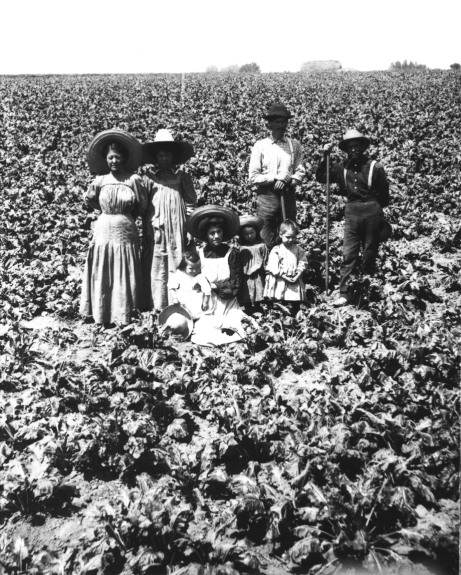About 1860, Swedish immigrant Peter Magnes grew the first sugar beets in Colorado Territory. At the time, the Swede casually predicted that these root crops would bring more wealth than all of the miners in the mountains. He was right. After many mines went bust, sugar beets grown on the plains fueled a “white gold” economy in Boulder County for decades.
Agriculture scientists determined that with good irrigation, large white beets (Beta vulgaris) yielding a high sugar content could be successfully grown in Boulder County soil. In 1903, a sugar refining factory that would become part of the Great Western Sugar Co. was built in Longmont, one of more than 20 sugar plants in Colorado. The big sugar vision was promising, enticing wealthy capitalists such as Charles Boettcher to diversify into the business.
Boettcher’s Great Western Sugar Co. contracted with local farm owners, who discovered they couldn’t handle all of the laborious tasks themselves. Cultivating sugar beets included backbreaking work of constant weeding and tedious thinning, often performed on hands and knees. In October, when beet sugar content reached its peak, the harvest required digging up each stubborn beet by hand, and then topping beets using a large sharp knife with precision so as not to take away from their weight.

Mexican migrant workers and their children pose in a field of sugarbeets in Niwot, Colo., in 1908. (Carnegie Library for Local History/Courtesy photo)
Filling jobs in the fields was a constant challenge.
East Boulder County coal mines shut down during the summers, so some of those men picked up work in the beet fields. Boulder high school boys found summer jobs in the fields, too.
But it was immigrant labor that became essential to local beet operations.
Local Japanese immigrants were hired for their gardening skills. Beginning in the early 1900s, German-Russians “Wolgadeutsche” immigrated to Colorado with experience from sugar beet fields in Europe and became a significant percentage of the workforce.
Sugar companies recruited migrant Mexican workers in southern Colorado, New Mexico, and Texas. Before child labor laws, they encouraged entire families to work together.
The Bracero program, a government agreement from 1942-1964, brought Mexican workers up to sugar beet fields all over Colorado.
During the World War II labor shortage, Great Western Sugar arranged for hundreds of Italian, German and Slavic prisoners of war to work in the beet fields and housed the POWs in company dormitories.
County residents were proud of the beet sugar industry for its economic value. The “2 for 1” crop sourced sugar for baking and fruit preserving and used surplus and tops to fatten sheep and cattle before market. Big sugar also created coal production jobs for the factories, and railroad positions for transporting the harvest.
The sugar beet industry was helped along for decades by government commodity support programs, minimum price guarantees, as well as tariffs and quotas for cane sugar imports.
In the 1960s, corn syrup was produced as a cheap sweetener, cane sugar competition increased, and industry regulations changed, causing the local sugar beet economy to collapse. After seven decades, Great Western Sugar Co. shuttered their Longmont factory in 1977.